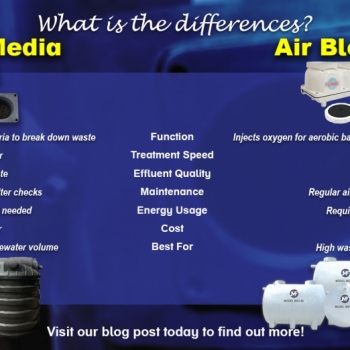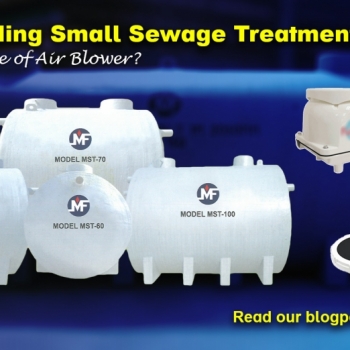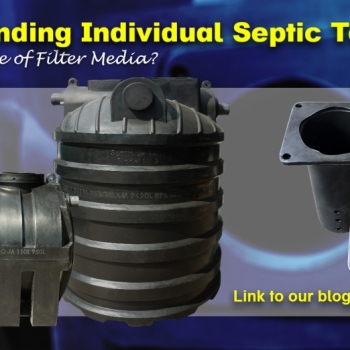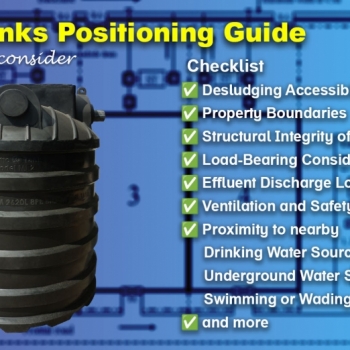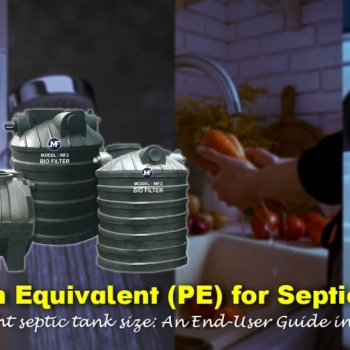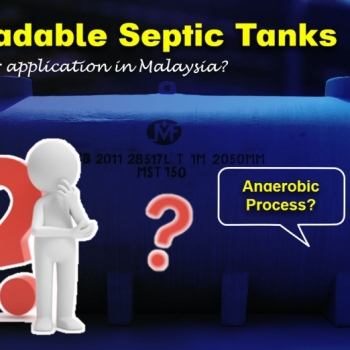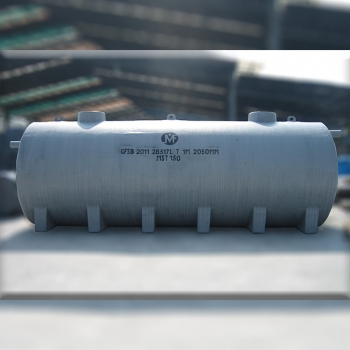Choosing between an individual septic tank with filter media and a mechanical septic tank with an air blower depends on efficiency, cost, and maintenance. This article breaks down their key differences to help you select the right wastewater treatment solution.
1. What is the meaning of “PE” term for Septic Tank?
Population equivalent (PE) or unit per capita loading, or equivalent person (EP), is a parameter for characterizing industrial wastewaters. It essentially compares the polluting potential of an industry (in terms of biodegradable organic matter) with a population (or certain number of people), which would produce the same polluting load. In other words, it is the number expressing the ratio of the sum of the pollution load produced during 24 hours by industrial facilities and services to the individual pollution load in household sewage produced by one person in the same time. This refers to the amount of oxygen-demanding substances in wastewater which will consume oxygen as it bio-degrades, usually as a result of bacterial activity.To design a network of pipes, pumping stations and sewage processing plants, an estimate should be made on the expected volume flow rate to be carried, pumped and treated. This flow rate is measured in cubic meters per second and should be calculated for existing use as well as for future development. There are various methods for calculating the expected flow rate. One of the methods is to calculate a parameter called "Population Equivalent (PE)" for an area and convert it to a flow rate.
PE is an estimate of the use of sewerage facilities. It's not a measure of population.
For residential areas, the population match is calculated as five (5) for each house and is a direct measure for residents in one area.
However, for commercial areas, PE is calculated based on the floor area, which is commensurate with the number of residents who use the premises. This does not indicate the number of residents living in the area.
The table below shows how PE is calculated.
| Type of Establishment | Population Equivalent |
|---|---|
| Residential | 5 per house |
| Commercial : Includes offices, shopping complex, entertainment / recreational centres, restaurants, cafeteria and theatres |
3 per 100m2 gross area |
| School / Educational Institutions : - Day schools / Institutions - Fully residential - Partial residential |
0.2 per student 1 per student 0.2 per non-residential student 1 per residential student |
| Hospitals | 4 per bed |
| Hotel with dining and laundry facilities | 4 per room |
| Factories, excluding process water | 0.3 per staff |
| Market (Wet Type) | 3 per stall |
| Market (Dry Type) | 1 per stall |
| Petrol kiosks / Service stations | 15 per toilet |
| Bus Terminal | 4 per bus bay |
| Taxi Terminal | 4 per taxi bay |
| Mosque / Church / Temple | 0.2 per person |
| Stadium | 0.2 per person |
| Swimming Pool or Sports Complex | 0.5 per person |
| Public Toilet | 15 per toilet |
| Airport | 0.2 per passenger/day 0.3 per employee |
| Laundry | 10 per machine |
| Prison | 1 per person |
| Golf Course | 20 per hole |
1. Apakah maksud istilah “PE” yang digunakan bagi tangki septik.
Purata Kesetaraan penduduk (PE) atau unit pemuatan per kapita, atau orang yang setara (EP), adalah parameter untuk mencirikan air sisa industri. Ia pada dasarnya membandingkan potensi pencemaran industri (dari segi bahan organik terbiodegradasi) dengan populasi (atau bilangan orang tertentu), yang akan menghasilkan beban pencemar yang sama. Dalam erti kata lain, ia adalah nombor yang menyatakan nisbah jumlah beban pencemaran yang dihasilkan dalam tempoh 24 jam oleh kemudahan dan perkhidmatan industri kepada beban pencemaran individu dalam kumbahan isi rumah yang dihasilkan oleh satu orang dalam masa yang sama. Ini merujuk kepada jumlah bahan yang menuntut oksigen dalam air sisa yang akan menggunakan oksigen kerana ia merosot bio, biasanya akibat aktiviti bakteria. Untuk merancang rangkaian paip, stesen pam dan loji pemprosesan kumbahan, anggaran harus dibuat pada kadar aliran isipadu yang diharapkan untuk dibawa, dipam dan dirawat. Kadar aliran ini diukur dalam meter padu sesaat dan harus dikira untuk kegunaan sedia ada dan juga untuk pembangunan masa depan. Terdapat pelbagai kaedah untuk mengira kadar aliran yang dijangkakan. Salah satu kaedah adalah untuk mengira parameter yang dipanggil "Population Equivalent (PE)" untuk kawasan dan menukarnya kepada kadar aliran. PE adalah anggaran penggunaan kemudahan pembetungan. Ini bukan ukuran populasi. Bagi kawasan kediaman, padanan penduduk dikira sebagai lima (5) untuk setiap rumah dan merupakan ukuran langsung bagi penduduk di satu kawasan. Walau bagaimanapun, untuk kawasan komersial, PE dikira berdasarkan kawasan lantai, yang sepadan dengan bilangan penduduk yang menggunakan premis tersebut. Ini tidak menunjukkan bilangan penduduk yang tinggal di kawasan itu.
2. How do i determine the suitable model of my propose septic tank?
The method of choosing a suitable or equivalent septic tank according to a development proposal is based on certain criteria. This is to facilitate the stakeholders to determine the appropriate septic tank specifications when drafting the preparation of the ESWAP submission procedure via Indah Water certifying Agency (IWK). Consultancy services on the products, types, models and brands of a specific septic tank can be consulted through the supplier for latest information on the purpose. The selection to determine the septic tank model for a proposal includes the following criteria:
1) Types of development proposals (e.g : Housing, Commercial, Factory and others)
2) Breakdown of calculation Population equivalent (PE) (e.g. 1 x 5PE/House = 5PE)
3) Limitation of space and installation area
2. Bagaimanakah saya menentukan model tangki septik yang sesuai dengan cadangan saya?
Kaedah memilih tangki septik yang sesuai atau setara mengikut cadangan pembangunan adalah berdasarkan kriteria tertentu. Ini adalah untuk memudahkan pihak berkepentingan menentukan spesifikasi tangki septik yang sesuai semasa merangka penyediaan prosedur penyerahan ESWAP melalui Agensi Perakuan Pembetungan (IWK).Khidmat konsultansi berhubung produk, jenis, model dan jenama sesuatu tangki septik boleh dirujuk melalui pihak pembekal bagi mendapatkan informasi terkini bagi tujuan tersebut. Pemilihan bagi menentukan model tangki septik bagi sesuatu cadangan merangkumi kriteria-kriteria yang berikut :
1) Jenis cadangan pembangunan (cth : Perumahan, Komersil, Kilang dan lain-lain)
2) Pecahan pengiraan purata keserataan penduduk (PE) (cth 1 x 5PE/House = 5PE)
3) Limitasi ruang dan kawasan pemasangan
3. What is the minimum & maximum effective volume capacity of a septic tank?
Septic tank consists of one unit vertical/horizontal cylindrical tank manufactured in various lengths of configurations to suit design sewage flow rates applicable to a range of population equivalent from minimum of 5 PE up to a maximum of 30 PE. In Malaysia these septic tanks commonly manufactured locally pre-fabricated using Polyethylene (P.E), Fiber reinforced Plastic material (FRP) or Reinforced precast concrete material. These septic tanks are generally in the form of vertically/horizontally-mounted cylinder with minimum effective working volume shall be calculated excluding filter media volume and accumulated sludge volume over 2 years (Desludging and maintenance purposes). This is to ensure the individual septic tank is able to meet the 24 hours hydraulic retention time after 2 years of installation.
The table below shown varies of minimum and maximum effective working volume in litres :
| Population equivalent | Effective working volume | Population Equivalent | Effective working volume |
|---|---|---|---|
| 5 | 1525 | 18 | 5490 |
| 6 | 1830 | 19 | 5795 |
| 7 | 2135 | 20 | 6100 |
| 8 | 2440 | 21 | 6405 |
| 9 | 2745 | 22 | 6710 |
| 10 | 3050 | 23 | 7015 |
| 11 | 3355 | 24 | 7320 |
| 12 | 3660 | 25 | 7625 |
| 13 | 3965 | 26 | 7930 |
| 14 | 4270 | 27 | 8235 |
| 15 | 4575 | 28 | 8540 |
| 16 | 4880 | 29 | 8845 |
| 17 | 5185 | 30 | 9150 |
Notes:
- Figures extracted from Malaysian Sewerage Industry Guidelines Volume 5, Septic Tanks, 3rd Edition
- The Volumetric sizing of tank is based on per capita sewage generation rate of 225 litre per day for a hydraulic retention time of 24 h.
- Septic tank is regulated under requirement of Water Services Industry Act 2006 (Act 655)
3. Apakah kapasiti isipadu efektif minimum dan maksimum bagi tangki septik?
Tangki septik terdiri daripada satu unit tangki silinder menegak / mendatar yang dihasilkan dalam pelbagai panjang konfigurasi untuk memenuhi kadar aliran kumbahan reka bentuk yang berlaku untuk pelbagai populasi yang setara dari minimum 5 PE sehingga maksimum 30 PE. Di Malaysia, tangki septik ini biasanya dihasilkan secara tempatan pra-fabrikasi menggunakan Polietilena (P.E), Bahan Plastik Bertetulang Gentian (FRP) atau bahan konkrit pra-tuang bertetulang. Tangki septik ini secara amnya dalam bentuk silinder yang dipasang secara menegak / mendatar dengan jumlah kerja efektif minimum akan dikira tidak termasuk jumlah media penapis dan jumlah enapcemar terkumpul selama 2 tahun (Tujuan nyah enapcemar dan penyelenggaraan).
Ini adalah untuk memastikan tangki septik individu dapat memenuhi masa pengekalan hidraulik 24 jam selepas 2 tahun pemasangan.
4. How do you get the size and impact of the wastewater treatment plant?
The size of sewage treatment plants has different variations and environmental impacts when compared to small commercial systems with low associated works matrix risk such as septic tanks and small sewage treatment plants (SSTS) according to the scoring scale below:
| List of Works | Connection | Pumping Station | Sewage Treatment Plant | Small Sewage Treatment System | Septic Tanks |
|---|---|---|---|---|---|
| Construction | 2 | 3 | 3 | 1 | 1 |
| Alteration | 2 | 3 | 3 | 1 | 1 |
| Disconnection | 2 | 3 | 3 | 1 | 1 |
| Close Up | 2 | 3 | 3 | 1 | 1 |
|
Note: Risk Scoring |
1 |
Least Risk : Very low impact, confined and localized harm/Threat |
|||
| 2 | Slight risk : Low Impact, limited spread of harm/threat | ||||
| 3 |
Moderate Risk : Reasonably impactful, harm/threat extended beyond localize limit. |
||||
4. Bagaimana anda mendapatkan saiz dan impak loji rawatan kumbahan?
Saiz loji rawatan kumbahan mempunyai variasi dan impak persekitaran berlainan jika dibandingkan sistem komersil kecil yang mempunyai risiko matriks yang rendah seperti tangki septik dan loji rawatan kumbahan kecil (SSTS) mengikut pemarkahan skala di atas:
-prepare by Zawahir, Technical Sales last revision June 2022
Disclaimer:-
The information provided on this website is for general informational purposes only and does not constitute legal advice. While we strive to ensure the accuracy and reliability of the information provided, we make no representations or warranties of any kind, express or implied, about the completeness, accuracy, reliability, suitability, or availability concerning the information contained herein. Any reliance you place on such information is therefore strictly at your own risk. This website may contain links to other third-party websites. Such links are only for the convenience of the reader, user, or browser; which we do not warrant, recommend, endorse, or assume liability for the contents of the third-party sites.
Keep in touch with us should you be keen on receiving timely updates from us
- Website - https://www.muifatt.com.my/home/
- Facebook - https://www.facebook.com/muifattmarketing
- Instagram - https://www.instagram.com/muifattmarketing/
- Google - https://goo.gl/maps/WxVY13gNcaRTS7Jp6
- Youtube - http://www.youtube.com/@MuiFattMarketing
- TikTok - https://www.tiktok.com/@muifattmarketing
- LinkedIn - https://www.linkedin.com/company/mui-fatt-marketing-sdn-bhd-
- Linktree - https://linktr.ee/muifattmarketing
- Shopee - https://www.shopee.com.my/muifattmarketing
- Lazada - https://www.lazada.com.my/shop/mui-fatt-marketing
Recent Blog
The Role of Air Blower in Mechanical Septic Tanks
Unlike traditional septic systems, mechanical septic tanks use air blowers to accelerate wastewater treatment. This article explores how air blowers enhance aeration, promote bacterial breakdown, and ensure a more effective sewage treatment system in Malaysia.
The Role of Filter Media in Individual Septic Tanks
Filter media plays a critical role in solid-liquid separation and biological treatment in individual septic tanks. This article explores the importance, types, and benefits of filter media in wastewater treatment, helping you make an informed decision when selecting a septic system in Malaysia.
Where Should You Place Your Septic Tank? Key Factors to Consider
Proper septic tank placement is crucial for efficient wastewater treatment. Learn why septic tanks should not be placed inside a house, how their location impacts wastewater disposal, and how to determine the best site for installation.
Simplified IWK Submission Process for Septic Tank Approvals in Malaysia
Navigating the IWK submission process can be challenging. Discover our simplified steps and professional advice for hassle-free septic tank approvals.
Understanding Population Equivalent (PE) for Septic Tanks: An End-User Guide
Discover what Population Equivalent (PE) is and its importance for septic systems, with an easy-to-follow guide for end-users, potential issues of choosing the wrong capacity, and expert tips from Mui Fatt.
Understanding Biodegradable Septic Tanks: A Guide in Malaysia
This article explores biodegradable septic tanks, covering their materials, operations, costs, and maintenance. It also explains why they're rare in Malaysia and introduces alternative sustainable options.
Why Desludging Your Septic Tank Every 2 Years Matters
Regular septic tank desludging ensures efficiency, prevents costly repairs, and protects your environment. Learn the top 10 reasons why this process is critical every two years.



